Business Law Assignment - Tame v New South Wales
VerifiedAdded on 2020/03/16
|11
|2826
|46
AI Summary
Contribute Materials
Your contribution can guide someone’s learning journey. Share your
documents today.
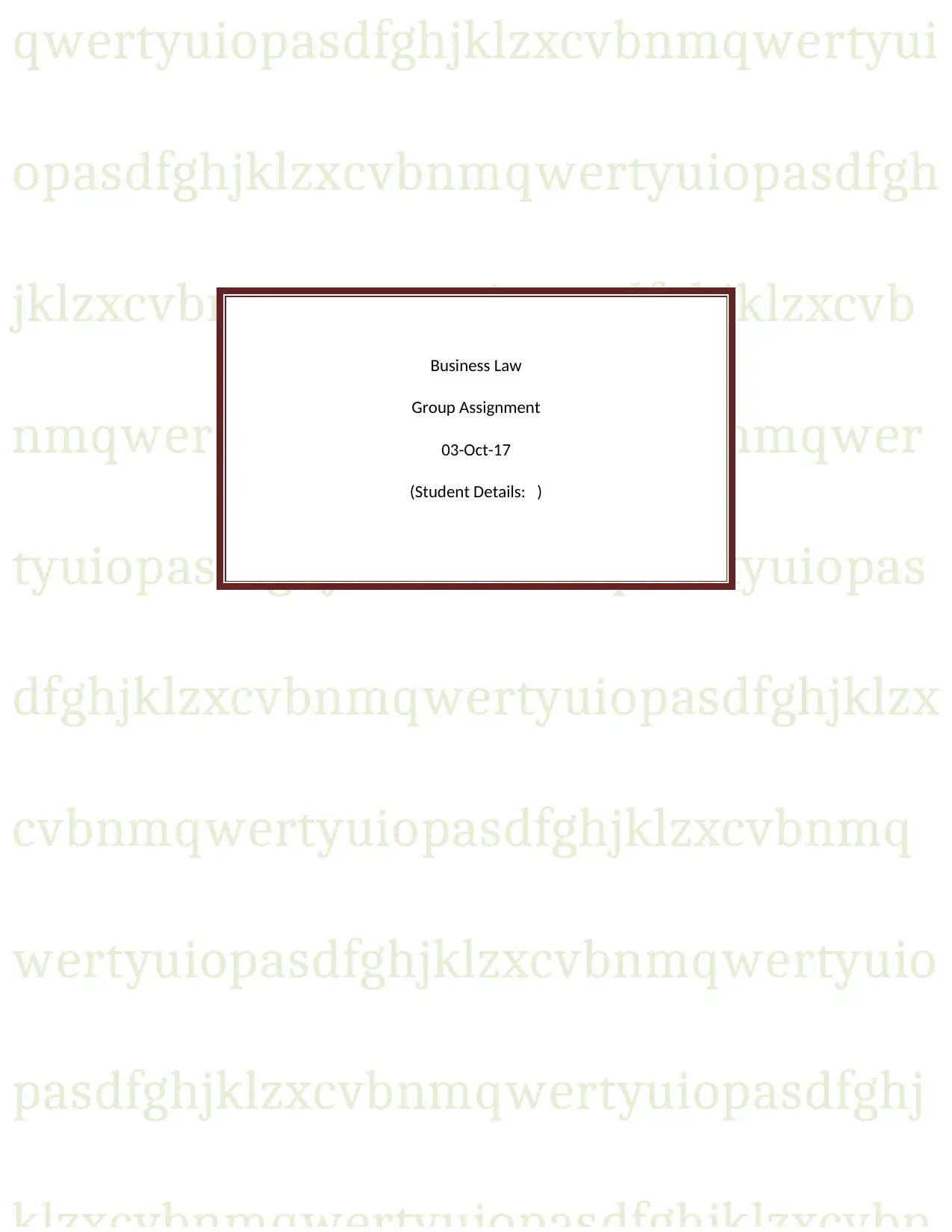
qwertyuiopasdfghjklzxcvbnmqwertyui
opasdfghjklzxcvbnmqwertyuiopasdfgh
jklzxcvbnmqwertyuiopasdfghjklzxcvb
nmqwertyuiopasdfghjklzxcvbnmqwer
tyuiopasdfghjklzxcvbnmqwertyuiopas
dfghjklzxcvbnmqwertyuiopasdfghjklzx
cvbnmqwertyuiopasdfghjklzxcvbnmq
wertyuiopasdfghjklzxcvbnmqwertyuio
pasdfghjklzxcvbnmqwertyuiopasdfghj
Business Law
Group Assignment
03-Oct-17
(Student Details: )
opasdfghjklzxcvbnmqwertyuiopasdfgh
jklzxcvbnmqwertyuiopasdfghjklzxcvb
nmqwertyuiopasdfghjklzxcvbnmqwer
tyuiopasdfghjklzxcvbnmqwertyuiopas
dfghjklzxcvbnmqwertyuiopasdfghjklzx
cvbnmqwertyuiopasdfghjklzxcvbnmq
wertyuiopasdfghjklzxcvbnmqwertyuio
pasdfghjklzxcvbnmqwertyuiopasdfghj
Business Law
Group Assignment
03-Oct-17
(Student Details: )
Secure Best Marks with AI Grader
Need help grading? Try our AI Grader for instant feedback on your assignments.
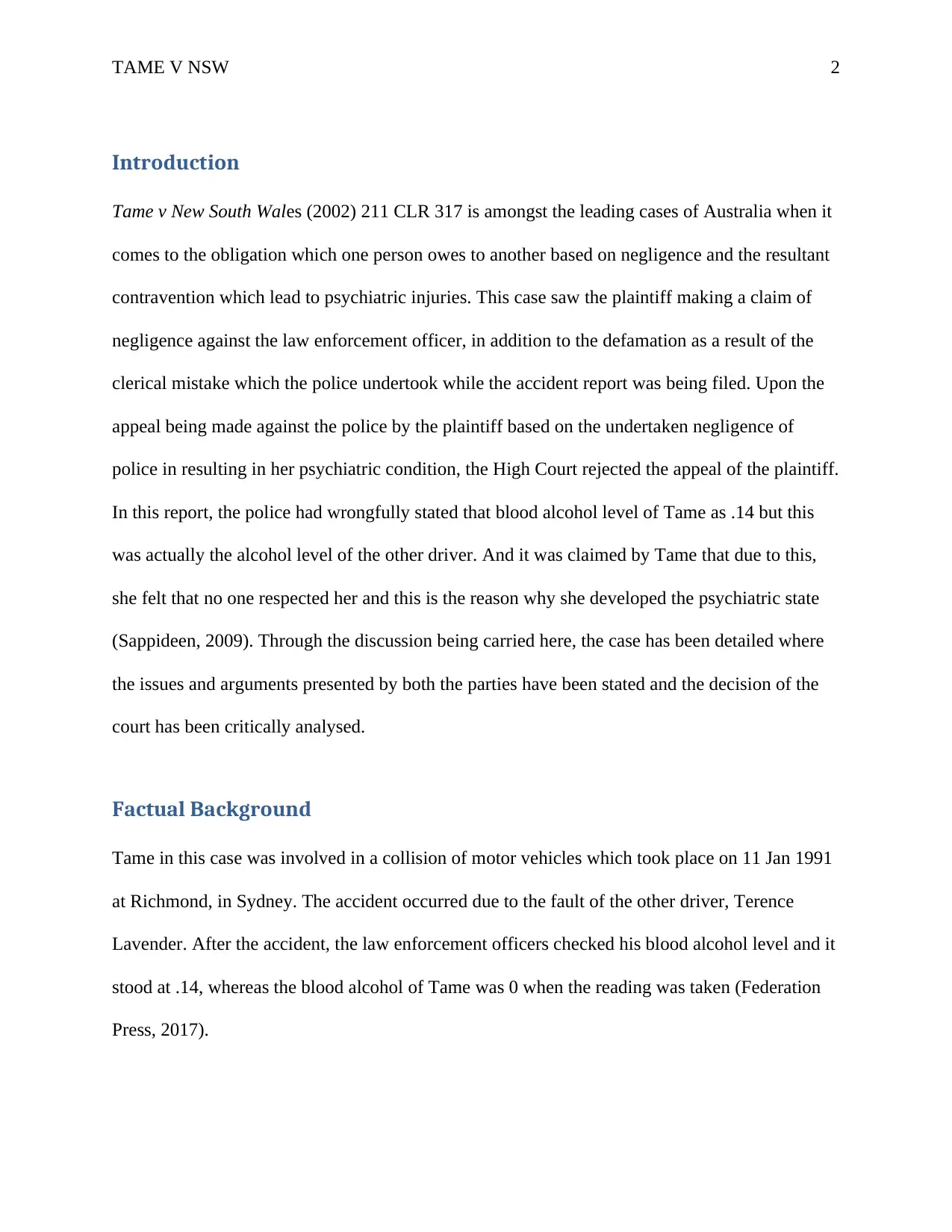
TAME V NSW 2
Introduction
Tame v New South Wales (2002) 211 CLR 317 is amongst the leading cases of Australia when it
comes to the obligation which one person owes to another based on negligence and the resultant
contravention which lead to psychiatric injuries. This case saw the plaintiff making a claim of
negligence against the law enforcement officer, in addition to the defamation as a result of the
clerical mistake which the police undertook while the accident report was being filed. Upon the
appeal being made against the police by the plaintiff based on the undertaken negligence of
police in resulting in her psychiatric condition, the High Court rejected the appeal of the plaintiff.
In this report, the police had wrongfully stated that blood alcohol level of Tame as .14 but this
was actually the alcohol level of the other driver. And it was claimed by Tame that due to this,
she felt that no one respected her and this is the reason why she developed the psychiatric state
(Sappideen, 2009). Through the discussion being carried here, the case has been detailed where
the issues and arguments presented by both the parties have been stated and the decision of the
court has been critically analysed.
Factual Background
Tame in this case was involved in a collision of motor vehicles which took place on 11 Jan 1991
at Richmond, in Sydney. The accident occurred due to the fault of the other driver, Terence
Lavender. After the accident, the law enforcement officers checked his blood alcohol level and it
stood at .14, whereas the blood alcohol of Tame was 0 when the reading was taken (Federation
Press, 2017).
Introduction
Tame v New South Wales (2002) 211 CLR 317 is amongst the leading cases of Australia when it
comes to the obligation which one person owes to another based on negligence and the resultant
contravention which lead to psychiatric injuries. This case saw the plaintiff making a claim of
negligence against the law enforcement officer, in addition to the defamation as a result of the
clerical mistake which the police undertook while the accident report was being filed. Upon the
appeal being made against the police by the plaintiff based on the undertaken negligence of
police in resulting in her psychiatric condition, the High Court rejected the appeal of the plaintiff.
In this report, the police had wrongfully stated that blood alcohol level of Tame as .14 but this
was actually the alcohol level of the other driver. And it was claimed by Tame that due to this,
she felt that no one respected her and this is the reason why she developed the psychiatric state
(Sappideen, 2009). Through the discussion being carried here, the case has been detailed where
the issues and arguments presented by both the parties have been stated and the decision of the
court has been critically analysed.
Factual Background
Tame in this case was involved in a collision of motor vehicles which took place on 11 Jan 1991
at Richmond, in Sydney. The accident occurred due to the fault of the other driver, Terence
Lavender. After the accident, the law enforcement officers checked his blood alcohol level and it
stood at .14, whereas the blood alcohol of Tame was 0 when the reading was taken (Federation
Press, 2017).

TAME V NSW 3
Constable Morgan was responsible for preparing the traffic collision report and he was a part of
the Windsor Police Station. While preparing this report at the incident spot, he left the blood
alcohol reading details of both Tame and the other driver as blank. In Feb 1991, the then acting
traffic sergeant filled these blank segments and while filing, accidently switched the blood
alcohol of both the drivers, where the other driver was stated to have 0 alcohol level and Tame to
have .14 as the blood alcohol level. In around Mar 1991, the mistake was detected by the acting
sergeant and he made corrections to the original report at this time (Health Law Central, 2017).
Lavender was sued by Tame since he was driving a vehicle which was not insured as was
required by the law and this claim was handled by NZI, which was the insurance company. Upon
the settlement of the claim, Tame was awarded a significant value. However, come May 1992,
the insurance company became hesitant when it came to payment of the physiotherapy treatment
which was needed by Tame as a result of her injuries and this made Tame very anxious. The
attorney of Tame, Wellers, was informed by Tame that she had no history of drinking and that
she had no current drinking issues since the last 20 years. The attorney was also informed that
the notion of being drunk was so wrong that she was horrified of it. This reaction of Tame was
highlighted upon Weller informing her that the report showed that Tame had been drunk when
the accident took place. And Tame was very apprehensive about her reputation which would be
damaged as a result of the grave error. The police issued a formal apology to Tame for their
mistake; and still Tame continued to blame the law enforcement for the NZI being reluctant in
their payments for her treatment. After some time, Tame became obsessed with this issue and
was clinically diagnosed with the “psychotic depressive illness”. As a result of this, a claim was
initiated by Tame in the NSW District Court against the police (Federation Press, 2017).
Constable Morgan was responsible for preparing the traffic collision report and he was a part of
the Windsor Police Station. While preparing this report at the incident spot, he left the blood
alcohol reading details of both Tame and the other driver as blank. In Feb 1991, the then acting
traffic sergeant filled these blank segments and while filing, accidently switched the blood
alcohol of both the drivers, where the other driver was stated to have 0 alcohol level and Tame to
have .14 as the blood alcohol level. In around Mar 1991, the mistake was detected by the acting
sergeant and he made corrections to the original report at this time (Health Law Central, 2017).
Lavender was sued by Tame since he was driving a vehicle which was not insured as was
required by the law and this claim was handled by NZI, which was the insurance company. Upon
the settlement of the claim, Tame was awarded a significant value. However, come May 1992,
the insurance company became hesitant when it came to payment of the physiotherapy treatment
which was needed by Tame as a result of her injuries and this made Tame very anxious. The
attorney of Tame, Wellers, was informed by Tame that she had no history of drinking and that
she had no current drinking issues since the last 20 years. The attorney was also informed that
the notion of being drunk was so wrong that she was horrified of it. This reaction of Tame was
highlighted upon Weller informing her that the report showed that Tame had been drunk when
the accident took place. And Tame was very apprehensive about her reputation which would be
damaged as a result of the grave error. The police issued a formal apology to Tame for their
mistake; and still Tame continued to blame the law enforcement for the NZI being reluctant in
their payments for her treatment. After some time, Tame became obsessed with this issue and
was clinically diagnosed with the “psychotic depressive illness”. As a result of this, a claim was
initiated by Tame in the NSW District Court against the police (Federation Press, 2017).
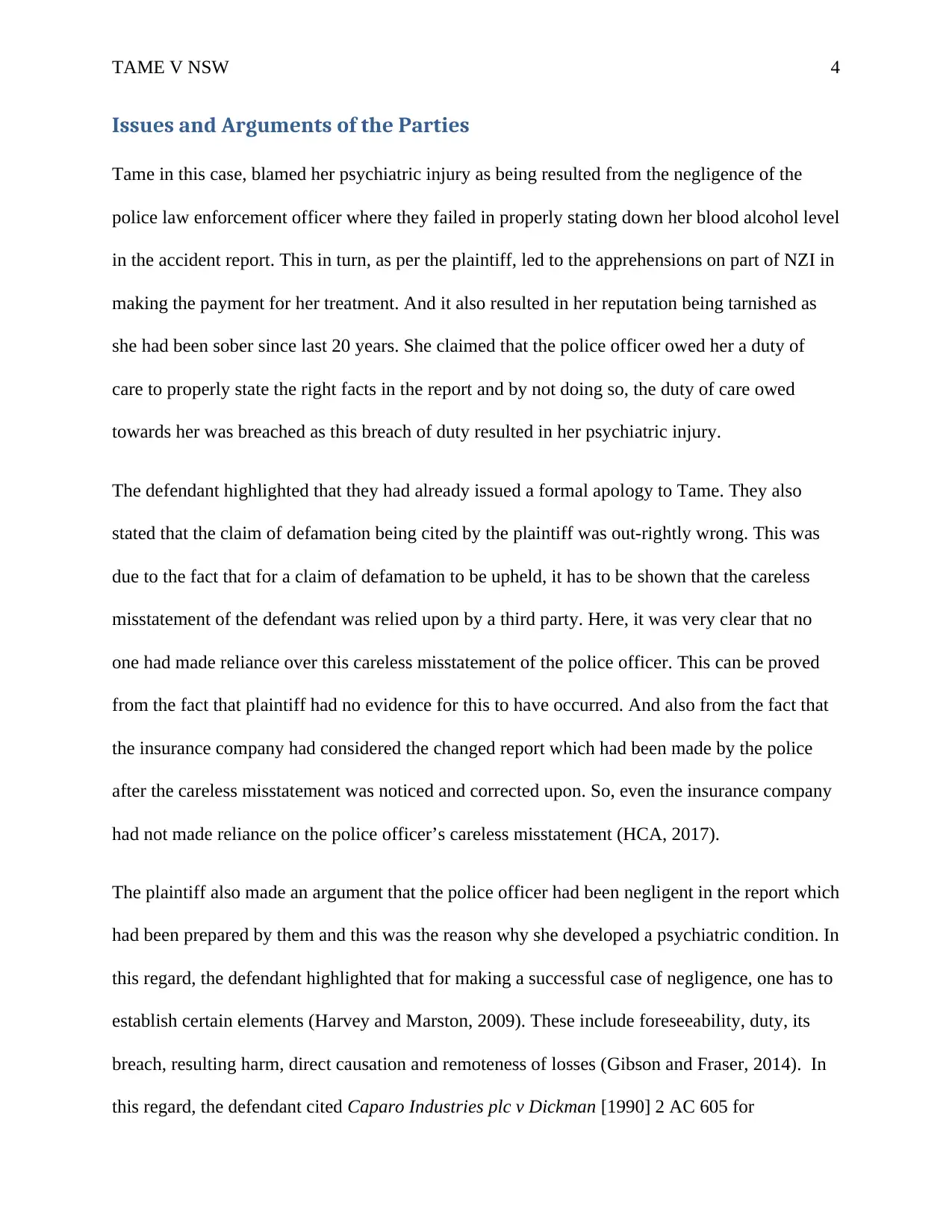
TAME V NSW 4
Issues and Arguments of the Parties
Tame in this case, blamed her psychiatric injury as being resulted from the negligence of the
police law enforcement officer where they failed in properly stating down her blood alcohol level
in the accident report. This in turn, as per the plaintiff, led to the apprehensions on part of NZI in
making the payment for her treatment. And it also resulted in her reputation being tarnished as
she had been sober since last 20 years. She claimed that the police officer owed her a duty of
care to properly state the right facts in the report and by not doing so, the duty of care owed
towards her was breached as this breach of duty resulted in her psychiatric injury.
The defendant highlighted that they had already issued a formal apology to Tame. They also
stated that the claim of defamation being cited by the plaintiff was out-rightly wrong. This was
due to the fact that for a claim of defamation to be upheld, it has to be shown that the careless
misstatement of the defendant was relied upon by a third party. Here, it was very clear that no
one had made reliance over this careless misstatement of the police officer. This can be proved
from the fact that plaintiff had no evidence for this to have occurred. And also from the fact that
the insurance company had considered the changed report which had been made by the police
after the careless misstatement was noticed and corrected upon. So, even the insurance company
had not made reliance on the police officer’s careless misstatement (HCA, 2017).
The plaintiff also made an argument that the police officer had been negligent in the report which
had been prepared by them and this was the reason why she developed a psychiatric condition. In
this regard, the defendant highlighted that for making a successful case of negligence, one has to
establish certain elements (Harvey and Marston, 2009). These include foreseeability, duty, its
breach, resulting harm, direct causation and remoteness of losses (Gibson and Fraser, 2014). In
this regard, the defendant cited Caparo Industries plc v Dickman [1990] 2 AC 605 for
Issues and Arguments of the Parties
Tame in this case, blamed her psychiatric injury as being resulted from the negligence of the
police law enforcement officer where they failed in properly stating down her blood alcohol level
in the accident report. This in turn, as per the plaintiff, led to the apprehensions on part of NZI in
making the payment for her treatment. And it also resulted in her reputation being tarnished as
she had been sober since last 20 years. She claimed that the police officer owed her a duty of
care to properly state the right facts in the report and by not doing so, the duty of care owed
towards her was breached as this breach of duty resulted in her psychiatric injury.
The defendant highlighted that they had already issued a formal apology to Tame. They also
stated that the claim of defamation being cited by the plaintiff was out-rightly wrong. This was
due to the fact that for a claim of defamation to be upheld, it has to be shown that the careless
misstatement of the defendant was relied upon by a third party. Here, it was very clear that no
one had made reliance over this careless misstatement of the police officer. This can be proved
from the fact that plaintiff had no evidence for this to have occurred. And also from the fact that
the insurance company had considered the changed report which had been made by the police
after the careless misstatement was noticed and corrected upon. So, even the insurance company
had not made reliance on the police officer’s careless misstatement (HCA, 2017).
The plaintiff also made an argument that the police officer had been negligent in the report which
had been prepared by them and this was the reason why she developed a psychiatric condition. In
this regard, the defendant highlighted that for making a successful case of negligence, one has to
establish certain elements (Harvey and Marston, 2009). These include foreseeability, duty, its
breach, resulting harm, direct causation and remoteness of losses (Gibson and Fraser, 2014). In
this regard, the defendant cited Caparo Industries plc v Dickman [1990] 2 AC 605 for
Paraphrase This Document
Need a fresh take? Get an instant paraphrase of this document with our AI Paraphraser
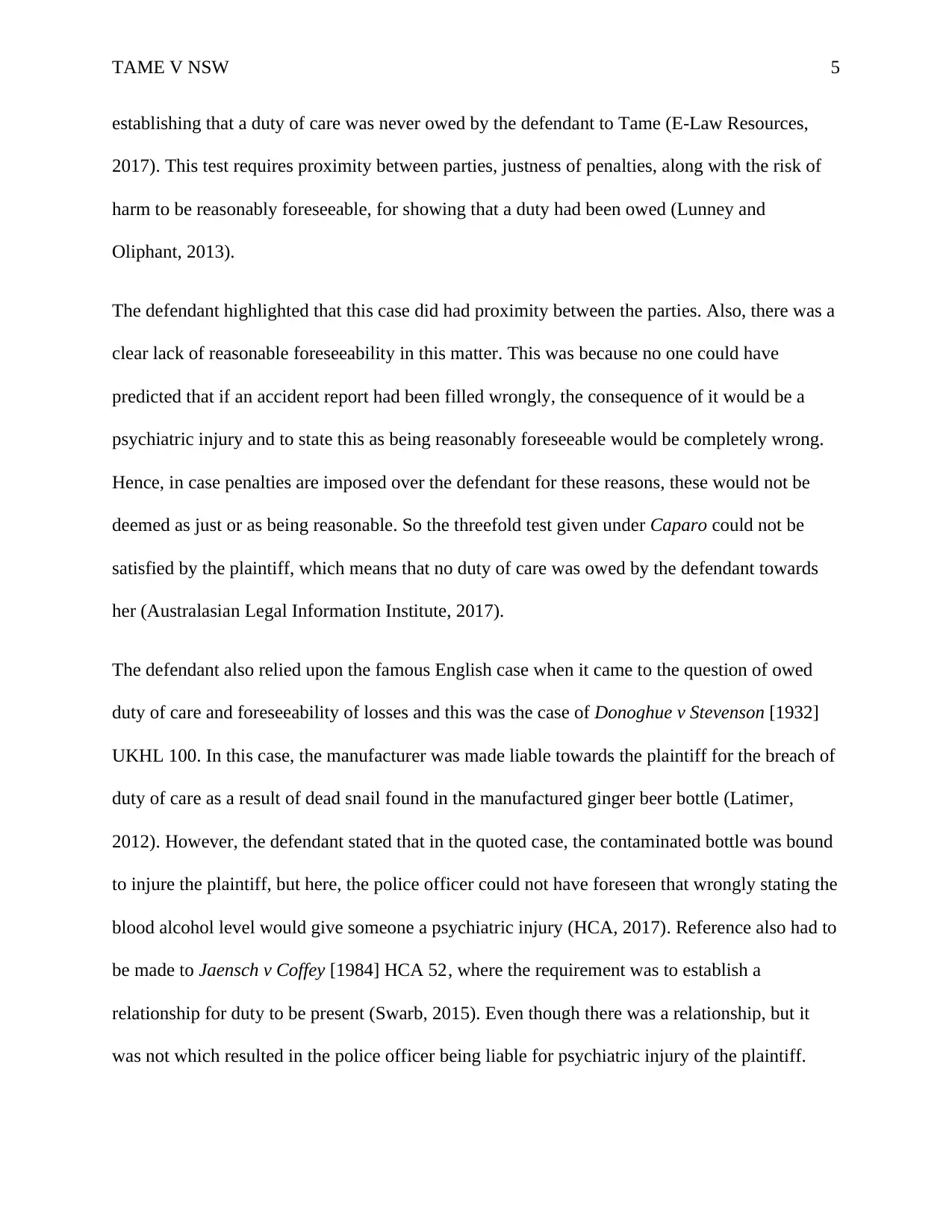
TAME V NSW 5
establishing that a duty of care was never owed by the defendant to Tame (E-Law Resources,
2017). This test requires proximity between parties, justness of penalties, along with the risk of
harm to be reasonably foreseeable, for showing that a duty had been owed (Lunney and
Oliphant, 2013).
The defendant highlighted that this case did had proximity between the parties. Also, there was a
clear lack of reasonable foreseeability in this matter. This was because no one could have
predicted that if an accident report had been filled wrongly, the consequence of it would be a
psychiatric injury and to state this as being reasonably foreseeable would be completely wrong.
Hence, in case penalties are imposed over the defendant for these reasons, these would not be
deemed as just or as being reasonable. So the threefold test given under Caparo could not be
satisfied by the plaintiff, which means that no duty of care was owed by the defendant towards
her (Australasian Legal Information Institute, 2017).
The defendant also relied upon the famous English case when it came to the question of owed
duty of care and foreseeability of losses and this was the case of Donoghue v Stevenson [1932]
UKHL 100. In this case, the manufacturer was made liable towards the plaintiff for the breach of
duty of care as a result of dead snail found in the manufactured ginger beer bottle (Latimer,
2012). However, the defendant stated that in the quoted case, the contaminated bottle was bound
to injure the plaintiff, but here, the police officer could not have foreseen that wrongly stating the
blood alcohol level would give someone a psychiatric injury (HCA, 2017). Reference also had to
be made to Jaensch v Coffey [1984] HCA 52, where the requirement was to establish a
relationship for duty to be present (Swarb, 2015). Even though there was a relationship, but it
was not which resulted in the police officer being liable for psychiatric injury of the plaintiff.
establishing that a duty of care was never owed by the defendant to Tame (E-Law Resources,
2017). This test requires proximity between parties, justness of penalties, along with the risk of
harm to be reasonably foreseeable, for showing that a duty had been owed (Lunney and
Oliphant, 2013).
The defendant highlighted that this case did had proximity between the parties. Also, there was a
clear lack of reasonable foreseeability in this matter. This was because no one could have
predicted that if an accident report had been filled wrongly, the consequence of it would be a
psychiatric injury and to state this as being reasonably foreseeable would be completely wrong.
Hence, in case penalties are imposed over the defendant for these reasons, these would not be
deemed as just or as being reasonable. So the threefold test given under Caparo could not be
satisfied by the plaintiff, which means that no duty of care was owed by the defendant towards
her (Australasian Legal Information Institute, 2017).
The defendant also relied upon the famous English case when it came to the question of owed
duty of care and foreseeability of losses and this was the case of Donoghue v Stevenson [1932]
UKHL 100. In this case, the manufacturer was made liable towards the plaintiff for the breach of
duty of care as a result of dead snail found in the manufactured ginger beer bottle (Latimer,
2012). However, the defendant stated that in the quoted case, the contaminated bottle was bound
to injure the plaintiff, but here, the police officer could not have foreseen that wrongly stating the
blood alcohol level would give someone a psychiatric injury (HCA, 2017). Reference also had to
be made to Jaensch v Coffey [1984] HCA 52, where the requirement was to establish a
relationship for duty to be present (Swarb, 2015). Even though there was a relationship, but it
was not which resulted in the police officer being liable for psychiatric injury of the plaintiff.
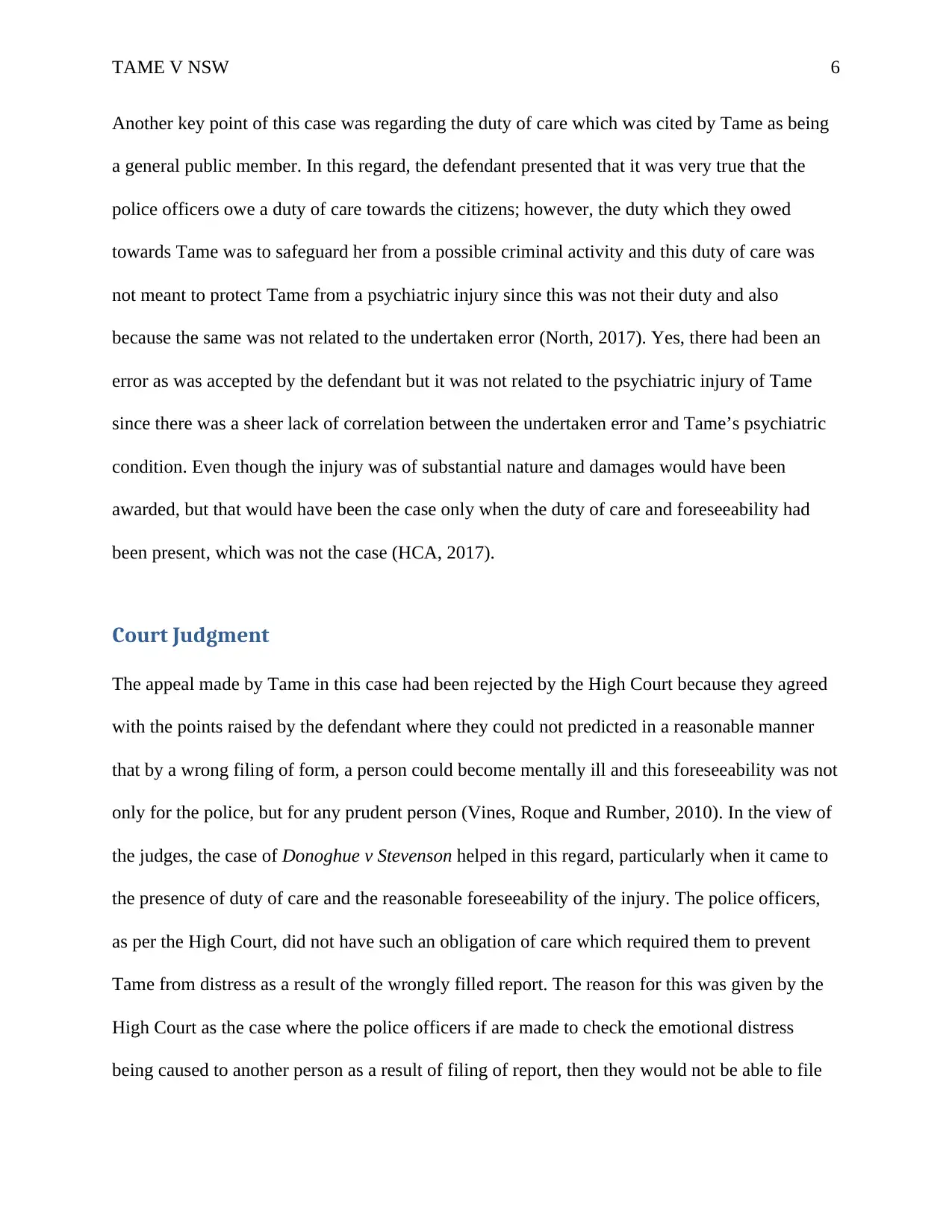
TAME V NSW 6
Another key point of this case was regarding the duty of care which was cited by Tame as being
a general public member. In this regard, the defendant presented that it was very true that the
police officers owe a duty of care towards the citizens; however, the duty which they owed
towards Tame was to safeguard her from a possible criminal activity and this duty of care was
not meant to protect Tame from a psychiatric injury since this was not their duty and also
because the same was not related to the undertaken error (North, 2017). Yes, there had been an
error as was accepted by the defendant but it was not related to the psychiatric injury of Tame
since there was a sheer lack of correlation between the undertaken error and Tame’s psychiatric
condition. Even though the injury was of substantial nature and damages would have been
awarded, but that would have been the case only when the duty of care and foreseeability had
been present, which was not the case (HCA, 2017).
Court Judgment
The appeal made by Tame in this case had been rejected by the High Court because they agreed
with the points raised by the defendant where they could not predicted in a reasonable manner
that by a wrong filing of form, a person could become mentally ill and this foreseeability was not
only for the police, but for any prudent person (Vines, Roque and Rumber, 2010). In the view of
the judges, the case of Donoghue v Stevenson helped in this regard, particularly when it came to
the presence of duty of care and the reasonable foreseeability of the injury. The police officers,
as per the High Court, did not have such an obligation of care which required them to prevent
Tame from distress as a result of the wrongly filled report. The reason for this was given by the
High Court as the case where the police officers if are made to check the emotional distress
being caused to another person as a result of filing of report, then they would not be able to file
Another key point of this case was regarding the duty of care which was cited by Tame as being
a general public member. In this regard, the defendant presented that it was very true that the
police officers owe a duty of care towards the citizens; however, the duty which they owed
towards Tame was to safeguard her from a possible criminal activity and this duty of care was
not meant to protect Tame from a psychiatric injury since this was not their duty and also
because the same was not related to the undertaken error (North, 2017). Yes, there had been an
error as was accepted by the defendant but it was not related to the psychiatric injury of Tame
since there was a sheer lack of correlation between the undertaken error and Tame’s psychiatric
condition. Even though the injury was of substantial nature and damages would have been
awarded, but that would have been the case only when the duty of care and foreseeability had
been present, which was not the case (HCA, 2017).
Court Judgment
The appeal made by Tame in this case had been rejected by the High Court because they agreed
with the points raised by the defendant where they could not predicted in a reasonable manner
that by a wrong filing of form, a person could become mentally ill and this foreseeability was not
only for the police, but for any prudent person (Vines, Roque and Rumber, 2010). In the view of
the judges, the case of Donoghue v Stevenson helped in this regard, particularly when it came to
the presence of duty of care and the reasonable foreseeability of the injury. The police officers,
as per the High Court, did not have such an obligation of care which required them to prevent
Tame from distress as a result of the wrongly filled report. The reason for this was given by the
High Court as the case where the police officers if are made to check the emotional distress
being caused to another person as a result of filing of report, then they would not be able to file
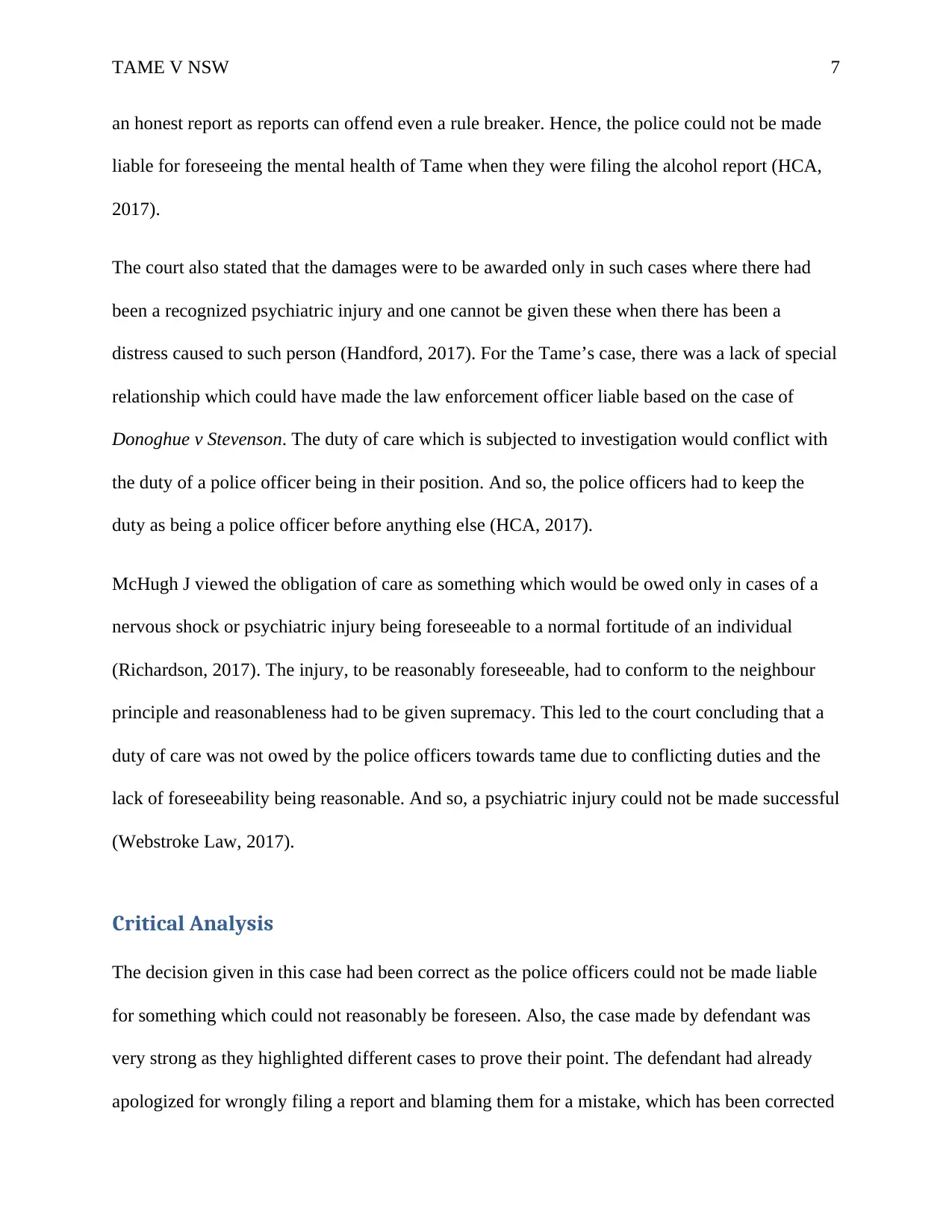
TAME V NSW 7
an honest report as reports can offend even a rule breaker. Hence, the police could not be made
liable for foreseeing the mental health of Tame when they were filing the alcohol report (HCA,
2017).
The court also stated that the damages were to be awarded only in such cases where there had
been a recognized psychiatric injury and one cannot be given these when there has been a
distress caused to such person (Handford, 2017). For the Tame’s case, there was a lack of special
relationship which could have made the law enforcement officer liable based on the case of
Donoghue v Stevenson. The duty of care which is subjected to investigation would conflict with
the duty of a police officer being in their position. And so, the police officers had to keep the
duty as being a police officer before anything else (HCA, 2017).
McHugh J viewed the obligation of care as something which would be owed only in cases of a
nervous shock or psychiatric injury being foreseeable to a normal fortitude of an individual
(Richardson, 2017). The injury, to be reasonably foreseeable, had to conform to the neighbour
principle and reasonableness had to be given supremacy. This led to the court concluding that a
duty of care was not owed by the police officers towards tame due to conflicting duties and the
lack of foreseeability being reasonable. And so, a psychiatric injury could not be made successful
(Webstroke Law, 2017).
Critical Analysis
The decision given in this case had been correct as the police officers could not be made liable
for something which could not reasonably be foreseen. Also, the case made by defendant was
very strong as they highlighted different cases to prove their point. The defendant had already
apologized for wrongly filing a report and blaming them for a mistake, which has been corrected
an honest report as reports can offend even a rule breaker. Hence, the police could not be made
liable for foreseeing the mental health of Tame when they were filing the alcohol report (HCA,
2017).
The court also stated that the damages were to be awarded only in such cases where there had
been a recognized psychiatric injury and one cannot be given these when there has been a
distress caused to such person (Handford, 2017). For the Tame’s case, there was a lack of special
relationship which could have made the law enforcement officer liable based on the case of
Donoghue v Stevenson. The duty of care which is subjected to investigation would conflict with
the duty of a police officer being in their position. And so, the police officers had to keep the
duty as being a police officer before anything else (HCA, 2017).
McHugh J viewed the obligation of care as something which would be owed only in cases of a
nervous shock or psychiatric injury being foreseeable to a normal fortitude of an individual
(Richardson, 2017). The injury, to be reasonably foreseeable, had to conform to the neighbour
principle and reasonableness had to be given supremacy. This led to the court concluding that a
duty of care was not owed by the police officers towards tame due to conflicting duties and the
lack of foreseeability being reasonable. And so, a psychiatric injury could not be made successful
(Webstroke Law, 2017).
Critical Analysis
The decision given in this case had been correct as the police officers could not be made liable
for something which could not reasonably be foreseen. Also, the case made by defendant was
very strong as they highlighted different cases to prove their point. The defendant had already
apologized for wrongly filing a report and blaming them for a mistake, which has been corrected
Secure Best Marks with AI Grader
Need help grading? Try our AI Grader for instant feedback on your assignments.

TAME V NSW 8
and which has shown to not have impacted the insurance company’s payments. Hence, the court
had rightly ruled in the favour of the defendant in this case.
and which has shown to not have impacted the insurance company’s payments. Hence, the court
had rightly ruled in the favour of the defendant in this case.

TAME V NSW 9
References
Australasian Legal Information Institute. (2017) Tame v New South Wales [2002] HCA 35; 211
CLR 317; 191 ALR 449; 76 ALJR 1348 (5 September 2002). [Online] Australasian Legal
Information Institute. Available from: http://www.austlii.edu.au/au/cases/cth/HCA/2002/35.html
[Accessed on: 03/10/17]
E-Law Resources. (2017) Caparo Industries pIc v Dickman [1990] 2 AC 605 House of Lords.
[Online] E-Law Resources. Available from: http://www.healthlawcentral.com/cases/tame-v-new-
south-wales/ [Accessed on: 03/10/17]
Federation Press. (2017) Tame v New South Wales Annetts v Australian Stations Pty Ltd.
[Online] Federation Press. Available from: http://www.federationpress.com.au/pdf/Tame%20v
%20New%20South%20Wales.pdf [Accessed on: 03/10/17]
Gibson, A., and Fraser, D. (2014) Business Law 2014. 8th ed. Melbourne: Pearson Education
Australia.
Handford, P. (2017) Psychiatric injury: the new era. [Online] The University of Western
Australia. Available from:
http://research-repository.uwa.edu.au/files/1003225/3609_PID3609.pdf [Accessed on: 03/10/17]
Harvey, B., and Marston, J. (2009) Cases and Commentary on Tort. 6th ed. New York: Oxford
University Press.
HCA. (2017) Tame v New South Wales [2002] HCA 35. [Online] HCA. Available from:
http://eresources.hcourt.gov.au/downloadPdf/2002/HCA/35 [Accessed on: 03/10/17]
References
Australasian Legal Information Institute. (2017) Tame v New South Wales [2002] HCA 35; 211
CLR 317; 191 ALR 449; 76 ALJR 1348 (5 September 2002). [Online] Australasian Legal
Information Institute. Available from: http://www.austlii.edu.au/au/cases/cth/HCA/2002/35.html
[Accessed on: 03/10/17]
E-Law Resources. (2017) Caparo Industries pIc v Dickman [1990] 2 AC 605 House of Lords.
[Online] E-Law Resources. Available from: http://www.healthlawcentral.com/cases/tame-v-new-
south-wales/ [Accessed on: 03/10/17]
Federation Press. (2017) Tame v New South Wales Annetts v Australian Stations Pty Ltd.
[Online] Federation Press. Available from: http://www.federationpress.com.au/pdf/Tame%20v
%20New%20South%20Wales.pdf [Accessed on: 03/10/17]
Gibson, A., and Fraser, D. (2014) Business Law 2014. 8th ed. Melbourne: Pearson Education
Australia.
Handford, P. (2017) Psychiatric injury: the new era. [Online] The University of Western
Australia. Available from:
http://research-repository.uwa.edu.au/files/1003225/3609_PID3609.pdf [Accessed on: 03/10/17]
Harvey, B., and Marston, J. (2009) Cases and Commentary on Tort. 6th ed. New York: Oxford
University Press.
HCA. (2017) Tame v New South Wales [2002] HCA 35. [Online] HCA. Available from:
http://eresources.hcourt.gov.au/downloadPdf/2002/HCA/35 [Accessed on: 03/10/17]
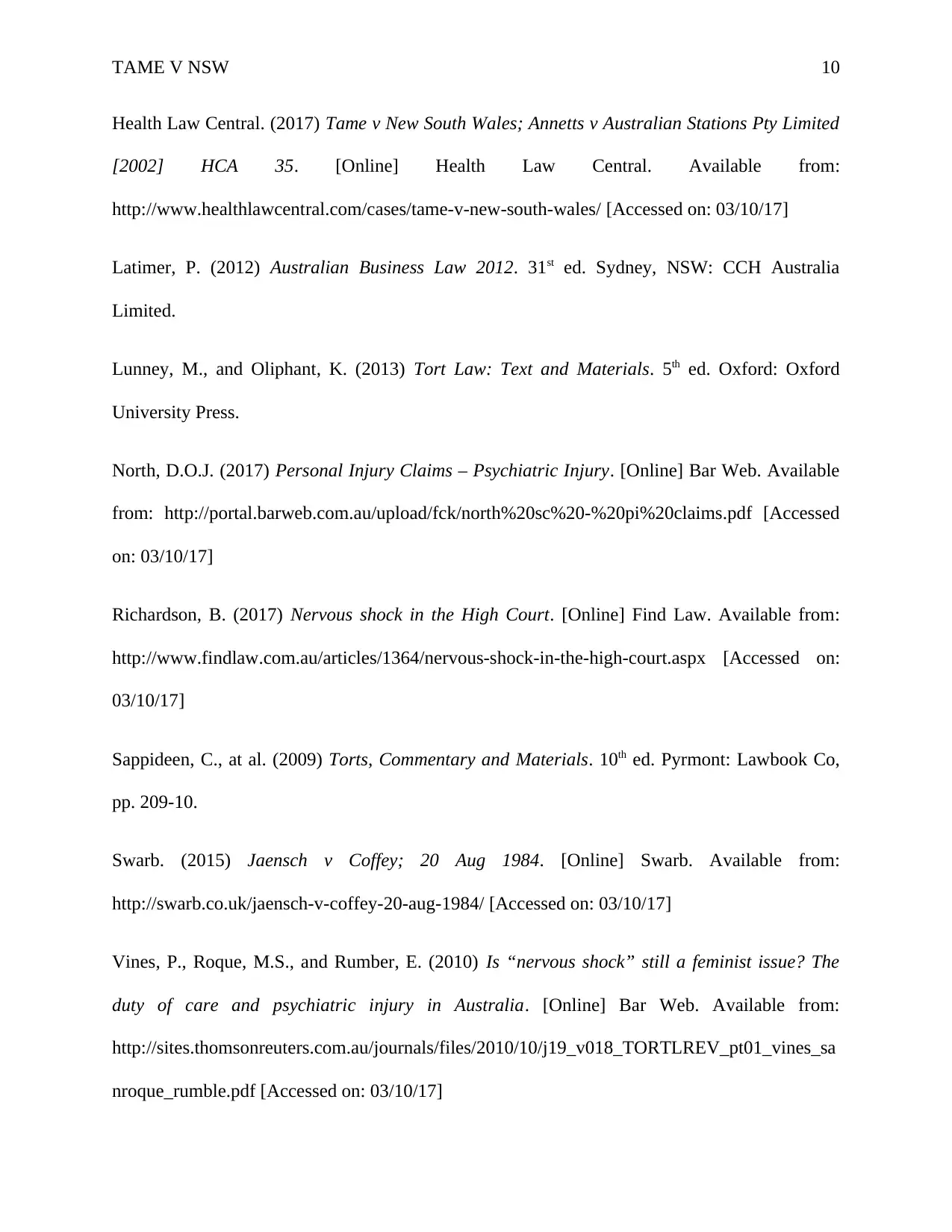
TAME V NSW 10
Health Law Central. (2017) Tame v New South Wales; Annetts v Australian Stations Pty Limited
[2002] HCA 35. [Online] Health Law Central. Available from:
http://www.healthlawcentral.com/cases/tame-v-new-south-wales/ [Accessed on: 03/10/17]
Latimer, P. (2012) Australian Business Law 2012. 31st ed. Sydney, NSW: CCH Australia
Limited.
Lunney, M., and Oliphant, K. (2013) Tort Law: Text and Materials. 5th ed. Oxford: Oxford
University Press.
North, D.O.J. (2017) Personal Injury Claims – Psychiatric Injury. [Online] Bar Web. Available
from: http://portal.barweb.com.au/upload/fck/north%20sc%20-%20pi%20claims.pdf [Accessed
on: 03/10/17]
Richardson, B. (2017) Nervous shock in the High Court. [Online] Find Law. Available from:
http://www.findlaw.com.au/articles/1364/nervous-shock-in-the-high-court.aspx [Accessed on:
03/10/17]
Sappideen, C., at al. (2009) Torts, Commentary and Materials. 10th ed. Pyrmont: Lawbook Co,
pp. 209-10.
Swarb. (2015) Jaensch v Coffey; 20 Aug 1984. [Online] Swarb. Available from:
http://swarb.co.uk/jaensch-v-coffey-20-aug-1984/ [Accessed on: 03/10/17]
Vines, P., Roque, M.S., and Rumber, E. (2010) Is “nervous shock” still a feminist issue? The
duty of care and psychiatric injury in Australia. [Online] Bar Web. Available from:
http://sites.thomsonreuters.com.au/journals/files/2010/10/j19_v018_TORTLREV_pt01_vines_sa
nroque_rumble.pdf [Accessed on: 03/10/17]
Health Law Central. (2017) Tame v New South Wales; Annetts v Australian Stations Pty Limited
[2002] HCA 35. [Online] Health Law Central. Available from:
http://www.healthlawcentral.com/cases/tame-v-new-south-wales/ [Accessed on: 03/10/17]
Latimer, P. (2012) Australian Business Law 2012. 31st ed. Sydney, NSW: CCH Australia
Limited.
Lunney, M., and Oliphant, K. (2013) Tort Law: Text and Materials. 5th ed. Oxford: Oxford
University Press.
North, D.O.J. (2017) Personal Injury Claims – Psychiatric Injury. [Online] Bar Web. Available
from: http://portal.barweb.com.au/upload/fck/north%20sc%20-%20pi%20claims.pdf [Accessed
on: 03/10/17]
Richardson, B. (2017) Nervous shock in the High Court. [Online] Find Law. Available from:
http://www.findlaw.com.au/articles/1364/nervous-shock-in-the-high-court.aspx [Accessed on:
03/10/17]
Sappideen, C., at al. (2009) Torts, Commentary and Materials. 10th ed. Pyrmont: Lawbook Co,
pp. 209-10.
Swarb. (2015) Jaensch v Coffey; 20 Aug 1984. [Online] Swarb. Available from:
http://swarb.co.uk/jaensch-v-coffey-20-aug-1984/ [Accessed on: 03/10/17]
Vines, P., Roque, M.S., and Rumber, E. (2010) Is “nervous shock” still a feminist issue? The
duty of care and psychiatric injury in Australia. [Online] Bar Web. Available from:
http://sites.thomsonreuters.com.au/journals/files/2010/10/j19_v018_TORTLREV_pt01_vines_sa
nroque_rumble.pdf [Accessed on: 03/10/17]
Paraphrase This Document
Need a fresh take? Get an instant paraphrase of this document with our AI Paraphraser
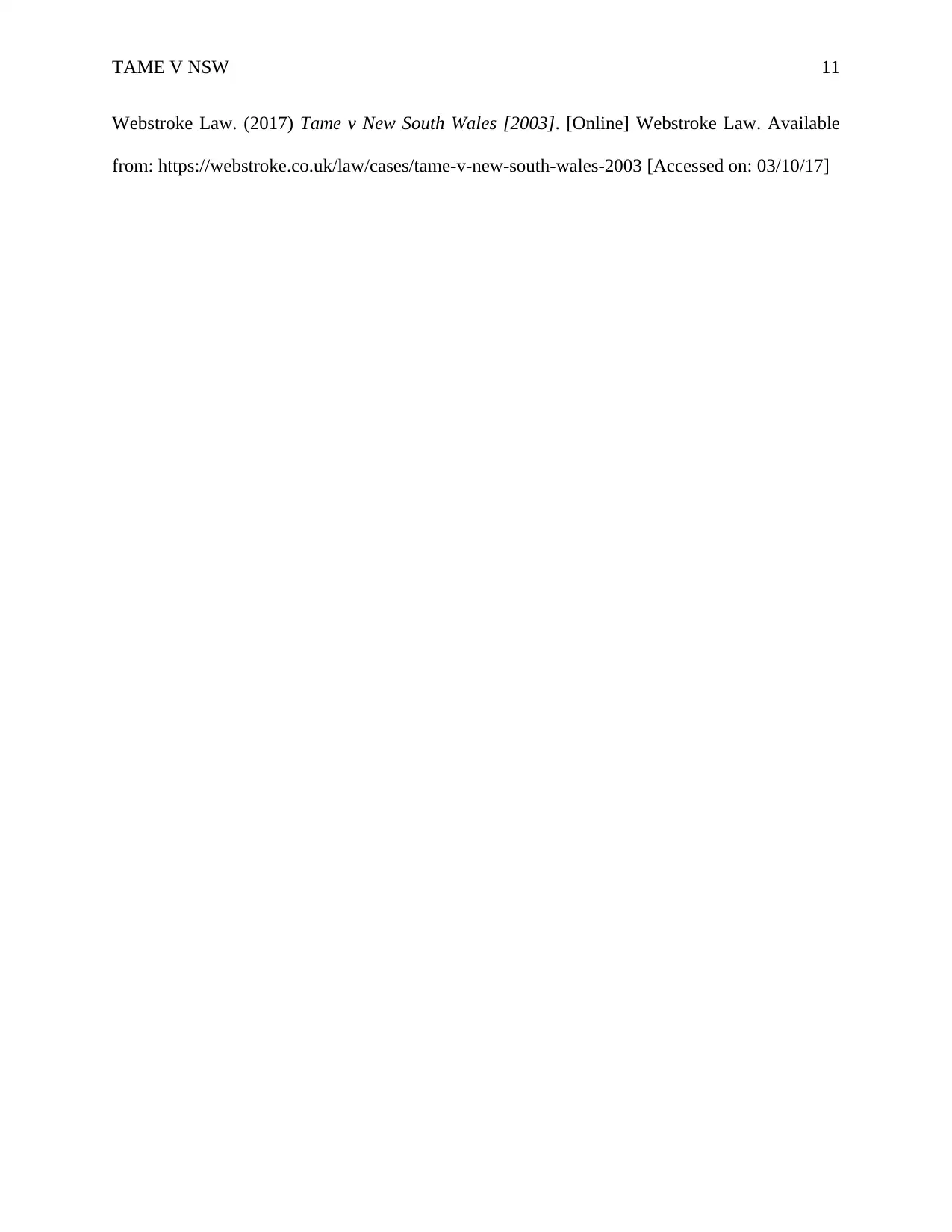
TAME V NSW 11
Webstroke Law. (2017) Tame v New South Wales [2003]. [Online] Webstroke Law. Available
from: https://webstroke.co.uk/law/cases/tame-v-new-south-wales-2003 [Accessed on: 03/10/17]
Webstroke Law. (2017) Tame v New South Wales [2003]. [Online] Webstroke Law. Available
from: https://webstroke.co.uk/law/cases/tame-v-new-south-wales-2003 [Accessed on: 03/10/17]
1 out of 11
Related Documents
Your All-in-One AI-Powered Toolkit for Academic Success.
+13062052269
info@desklib.com
Available 24*7 on WhatsApp / Email
![[object Object]](/_next/static/media/star-bottom.7253800d.svg)
Unlock your academic potential
© 2024 | Zucol Services PVT LTD | All rights reserved.